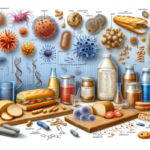In-Depth Analysis of Dried Blood Spot Testing: Transforming Healthcare Diagnostics
Exploring the Vital Importance of Dried Blood Spot Testing in Contemporary Medicine

Dried blood spot testing represents a revolutionary advancement in the field of blood sample collection and analysis, fundamentally reshaping the diagnostic capabilities available to healthcare professionals. This innovative procedure entails depositing a small droplet of blood onto specially designed filter paper, allowing it to dry before being dispatched to a laboratory for detailed examination. This technique simplifies the sample collection process while significantly mitigating the risks associated with traditional, invasive methods such as venous blood draws. The importance of this approach is underscored by its ability to facilitate accurate and prompt diagnoses, particularly in regions where healthcare resources are scarce or limited. By incorporating this technique into practice, healthcare providers can enhance patient outcomes and develop effective health management strategies that are both accessible and efficient.
The procedure of collecting samples through dried blood spot testing offers significant benefits for patients, particularly due to its minimally invasive nature, making it an optimal choice in pediatric care and for vulnerable populations. These dried samples can be stored for extended periods without refrigeration, making them especially useful for public health studies and diagnostics in remote or underserved areas. Moreover, this innovative approach allows for the evaluation of multiple biomarkers from a single sample, optimizing both time and resources compared to traditional testing methods. The advent of this testing methodology is substantially transforming the medical diagnostics landscape, opening new avenues for patient care and effective disease management.
Charting the Historical Development of Dried Blood Spot Testing
The origins of dried blood spot testing can be traced back to the 1960s and 1970s when it was initially introduced for the early detection of metabolic disorders in newborns. Since that time, remarkable advancements have been made in both the technique and the analytical processes involved. Rapid technological progress has refined the methodologies used for sample collection and analysis, allowing this technique to expand its applicability across diverse domains within clinical medicine.
In recent years, there has been a focused effort to broaden the use of dried blood spot testing across various fields, including the monitoring of infectious diseases, pharmacogenomics, and epidemiological research. This expansion is primarily driven by significant improvements in the sensitivity and specificity of testing protocols, along with the validation of analytical methods that ensure consistent and reliable results. Today, this technique is recognized worldwide as a crucial tool for diagnosing and tracking a wide range of health conditions, underscoring its growing importance in modern medical practices.
Identifying the Key Benefits of Dried Blood Spot Testing
One of the most notable advantages of dried blood spot testing is its inherently user-friendly design, which facilitates its implementation in various settings, ranging from hospitals to home environments, thereby significantly enhancing access to essential diagnostic testing. Additionally, the sample collection process does not necessitate highly specialized personnel, which effectively lowers operational costs and enables a broader range of individuals to benefit from this innovative method.
Another compelling benefit is the portability of dried samples. Once the blood spots have dried, they can be transported without the need for special storage conditions, which is especially advantageous in public health contexts and rural areas. This capability supports large-scale screening initiatives and the monitoring of disease outbreaks. Moreover, the ability to analyze multiple analytes from a single sample further maximizes resource efficiency in medical diagnostics, making this approach a highly effective option for healthcare providers.
Investigating the Practical Applications of Dried Blood Spot Testing in Healthcare

Revolutionizing Neonatal Disease Screening with Dried Blood Spot Testing
The application of dried blood spot testing for the identification of neonatal diseases has dramatically influenced the diagnosis and management of potentially life-threatening conditions in infants. This method enables the early detection of various metabolic, endocrine, and genetic disorders, which is crucial for initiating timely treatments that can save lives. Serious conditions, including phenylketonuria and congenital hypothyroidism, can be swiftly identified using this approach, allowing healthcare providers to implement rapid interventions that prevent long-term complications and promote healthier outcomes for newborns.
The implementation of neonatal screening programs utilizing dried blood spot testing has effectively reduced morbidity and infant mortality. Typically, newborns are screened within the first 48 hours of life, ensuring that any identified conditions receive immediate attention and treatment. Furthermore, the ability to conduct tests in home settings or community environments has significantly improved outreach and accessibility, benefiting populations that previously lacked sufficient access to quality healthcare resources.
The Influence of Dried Blood Spot Testing on Advancements in Medical Research
The versatility of dried blood spot testing extends beyond clinical diagnostics, playing a vital role in advancing medical research. Clinical studies frequently utilize this technique to collect blood samples in a less invasive manner, facilitating longitudinal data collection and ongoing health monitoring over time. Researchers can make use of dried blood samples to assess biomarkers, conduct pharmacokinetic studies, and evaluate the effectiveness of new treatments.
Epidemiological research is also significantly enhanced by this innovative technique. For example, studies aimed at assessing the prevalence of infectious diseases such as HIV and hepatitis have effectively utilized dried blood spot testing to investigate affected populations in various contexts. The capacity to store and analyze samples over extended periods allows for the collection of invaluable data that can shape public health strategies and inform health interventions.
Utilizing Dried Blood Spot Testing for Effective Therapy Management

The role of dried blood spot testing in therapy management is an expanding area of focus, particularly concerning chronic treatments and complex diseases. Healthcare providers can leverage this technique to optimize medication dosages, ensuring that patients receive the precise amount necessary to enhance treatment effectiveness while minimizing potential side effects. This precision is especially critical for medications that have a narrow therapeutic index, where accurate dosing is essential for patient safety and therapeutic success.
Additionally, dried blood spot testing allows healthcare professionals to continually monitor drug levels in patients’ systems, enabling timely adjustments based on individual responses. This capacity is particularly vital in fields such as oncology and pain management, where personalized treatment strategies can significantly enhance patient outcomes. The ease and effectiveness of this method position it as an invaluable asset in modern clinical practice.
Detailed Procedures and Techniques for Successful Dried Blood Spot Testing
Guidelines for Step-by-Step Sample Collection in Dried Blood Spot Testing
Collecting samples for dried blood spot testing necessitates meticulous attention to detail to ensure the highest quality of samples. The process begins with the preparation of essential materials, including specific filter papers and devices for blood collection. Adhering to standardized protocols is crucial to minimize contamination risks and guarantee reliable results during the entire process.
Once all necessary equipment is prepared, the next step involves puncturing the patient’s finger or heel, depending on the patient’s age and context. The blood volume required for this test is minimal; typically, only a few drops are needed. These drops are carefully applied onto the filter paper, ensuring they are absorbed adequately and evenly distributed. After collection, it is crucial that the samples dry completely before being stored or dispatched to the laboratory, as insufficient drying can compromise the integrity and reliability of the samples.
Advanced Analytical Techniques for Processing Dried Blood Samples
The analysis of samples obtained through dried blood spot testing employs a variety of biochemical and molecular methodologies. Upon reaching the laboratory, the dried samples undergo rehydration and preparation for comprehensive analysis. Depending on the specific condition or biomarker being assessed, methodologies such as mass spectrometry, liquid chromatography, and various immunoassay techniques may be utilized.
Each analytical method presents unique advantages in terms of sensitivity, specificity, and speed. For instance, mass spectrometry is highly regarded for its exceptional accuracy and ability to simultaneously identify multiple analytes. The selection of the appropriate analytical technique will depend on the objectives of the study and the resources available. Additionally, laboratories must adhere to stringent quality control measures to ensure the reliability of results obtained from dried blood spot testing samples.
Understanding the Interpretation of Results from Dried Blood Spot Testing
Interpreting results derived from dried blood spot testing is a critical process that requires specialized knowledge and expertise. Healthcare professionals must take into account numerous factors, including reference values, the patient’s clinical history, and the specific circumstances surrounding the sample collection. Accurate interpretation of test results is essential to guide critical treatment and management decisions for patients.
It is vital to recognize that while dried blood spot testing serves as a powerful diagnostic tool, it is not a replacement for all conventional diagnostic tests. The results should be contextualized within a broader clinical framework, and in certain instances, additional testing may be necessary to confirm diagnoses or assess treatment effectiveness. Clear and effective communication of results between healthcare providers and patients is essential for facilitating informed health management decisions.
Analyzing the Benefits and Challenges of Dried Blood Spot Testing
Distinct Advantages of Dried Blood Spot Testing Compared to Conventional Methods
The benefits of dried blood spot testing in comparison to traditional diagnostic approaches are numerous and significant. Primarily, the simplicity of the collection process greatly reduces patient discomfort and minimizes the risks associated with invasive procedures. Furthermore, the capacity to store and transport samples without refrigeration is a decisive factor in its widespread acceptance in both clinical and research settings.
Another major advantage is the ability to analyze multiple biomarkers from a single sample, thereby optimizing both resources and time compared to the necessity for multiple samples for individual tests. This efficiency is particularly crucial in the field of personalized medicine, where comprehensive health profiles can be derived from a single analysis. Moreover, this technique has proven effective in mass screening efforts, enabling the early identification of diseases in populations that are often difficult to reach, thereby enhancing overall public health outcomes and preventive care strategies.
Identifying Challenges and Limitations of Dried Blood Spot Testing
Despite its numerous advantages, dried blood spot testing also faces several challenges and limitations that require careful consideration. One primary concern is the variability in the quality of collected samples, which can directly impact the accuracy and reliability of results. Factors such as the technique employed for puncturing, drying time, and environmental conditions during transportation can all affect sample integrity.
The interpretation of results can also be complex, particularly for conditions that necessitate detailed assessments. It is essential for healthcare professionals to receive adequate training to accurately manage and analyze results. Lastly, although the technique has advanced significantly, the validation of new methods and biomarkers continues to be essential to ensure the reliability and acceptance of dried blood spot testing in clinical practice.
Envisioning the Future of Dried Blood Spot Testing
The future of dried blood spot testing holds tremendous promise, with ongoing advancements in technology and methodologies that continually expand its applications. The integration of cutting-edge analytical technologies, such as genomic sequencing and metabolomics, facilitates a more comprehensive evaluation of patient health and the early detection of emerging diseases.
Moreover, it is anticipated that the incorporation of this technique into public health initiatives will grow, thereby enhancing access to diagnostic testing in underserved communities. Collaboration among researchers, healthcare practitioners, and regulatory bodies will be crucial for overcoming existing challenges and fostering the widespread adoption of dried blood spot testing. As new applications emerge and innovative methods gain validation, this approach has the potential to revolutionize the diagnosis and management of diseases, establishing itself as a fundamental element in the future of healthcare.
Case Studies Highlighting the Impact of Dried Blood Spot Testing
Success Stories in Early Disease Detection Utilizing Dried Blood Spot Testing
Numerous success stories underscore the effectiveness of dried blood spot testing in the early detection of diseases in critical scenarios. For instance, several nations have adopted this methodology in neonatal screening programs aimed at identifying metabolic disorders. A notable study conducted in Sweden revealed that early detection of phenylketonuria through dried blood spot testing facilitated targeted dietary interventions that significantly improved patient health outcomes.
Another significant example is the application of dried blood spot testing in identifying infectious diseases. In a public health initiative in Africa, dried blood samples were utilized to quickly diagnose HIV in hard-to-reach communities. This approach not only allowed for timely diagnoses but also enabled immediate interventions to mitigate virus transmission, highlighting the critical role of this testing method in enhancing public health initiatives.
The Role of Dried Blood Spot Testing in Public Health Initiatives
The integration of dried blood spot testing into public health programs has emerged as a vital asset in combating both infectious and chronic diseases. This technique has been employed globally for epidemiological studies and mass screening initiatives targeting diseases such as malaria and hepatitis. The ability to efficiently collect and analyze blood samples empowers health authorities to make informed decisions and allocate resources effectively to areas in urgent need.
Furthermore, dried blood spot testing has significantly enhanced the response capability to epidemic outbreaks. During public health emergencies, such as the COVID-19 pandemic, this technique has served as a practical tool for surveillance and controlling the spread of the virus, enabling rapid identification of cases and the implementation of effective public health measures.
Innovative Progressions in Dried Blood Spot Testing
Continuous innovations in dried blood spot testing are propelling its evolution and expansion within clinical practice. One of the most significant advancements has been the enhancement of analytical technologies, which now allow for the detection of biomarkers at lower concentrations and with greater precision. This progress has broadened potential applications in fields such as pharmacogenomics, where patient responses to specific medications can be effectively evaluated using a dried blood sample.
Moreover, the development of portable devices for sample collection and analysis has facilitated the implementation of dried blood spot testing in community and rural settings. These devices empower healthcare professionals to conduct diagnostic testing on-site, thereby improving access to medical care for underserved populations. The future of this technique remains in continuous development, and its integration into clinical practice holds the promise of revolutionizing the diagnosis and management of diseases.
Frequently Asked Questions about Dried Blood Spot Testing
Is Dried Blood Spot Testing Painful for Patients?
The procedure associated with dried blood spot testing involves a minor puncture in the skin, akin to a needle prick. Most patients report experiencing minimal discomfort, as contemporary techniques are designed to minimize any potential pain associated with the process.
Where Can I Obtain a Dried Blood Spot Test?
Dried blood spot testing can be conducted in hospitals, clinics, and specialized laboratories. Additionally, several public health programs offer options for home collection, enhancing accessibility for various populations.
What Range of Diseases Can Be Detected Through Dried Blood Spot Testing?
This testing method effectively identifies a wide range of diseases, including metabolic disorders, infections such as HIV and hepatitis, as well as genetic conditions. Its versatility enables a broad spectrum of diagnostic applications across diverse healthcare settings.
What is the Typical Turnaround Time for Results from Dried Blood Spot Testing?
The turnaround time for results from dried blood spot testing can differ by laboratory but generally falls within a timeframe of 3 to 10 days, depending on the specific analysis being performed and the complexity of the tests.
Is Fasting Required Before Undergoing the Test?
Fasting is typically not necessary prior to dried blood spot testing. However, it is advisable to adhere to any specific instructions provided by the healthcare professional administering the test to ensure optimal conditions for accurate results.
What Storage Precautions Should Be Taken for Dried Blood Spot Samples?
Samples from dried blood spot testing should be stored in a cool, dry environment, shielded from direct light and humidity. This practice is essential to maintain the integrity of the sample until it is analyzed, ensuring reliable results.
Can Dried Blood Spot Testing Replace Other Diagnostic Procedures?
While dried blood spot testing is highly effective, it is not intended to replace all conventional diagnostic methods. Its utilization should complement existing procedures based on comprehensive clinical evaluations and the specific health context of the patient.
What Are the Typical Costs Associated with Dried Blood Spot Testing?
The costs of dried blood spot testing may vary based on the laboratory and specific tests conducted. It is advisable to consult with the healthcare institution for accurate pricing information and potential insurance coverage.
Are There Any Risks Associated with Dried Blood Spot Testing?
The risks related to dried blood spot testing are minimal, as the collection involves a minor puncture compared to other techniques. Nonetheless, there is a slight risk of infection at the puncture site, which can be mitigated through proper hygiene practices.
What Should I Do If My Results Are Abnormal?
If your dried blood spot testing results are abnormal, it is crucial to consult with a physician for appropriate follow-up and to determine the next steps, including any necessary additional testing to clarify the findings.
Connect with us on Facebook!
This Article Was First Found On https://bloodtest.co.uk
The Article: Dried Blood Spot Testing Benefits: A Comprehensive Guide appeared first on: https://ezbloodtest.com
The Article Benefits of Dried Blood Spot Testing: An Essential Overview Was Found On https://limitsofstrategy.com
